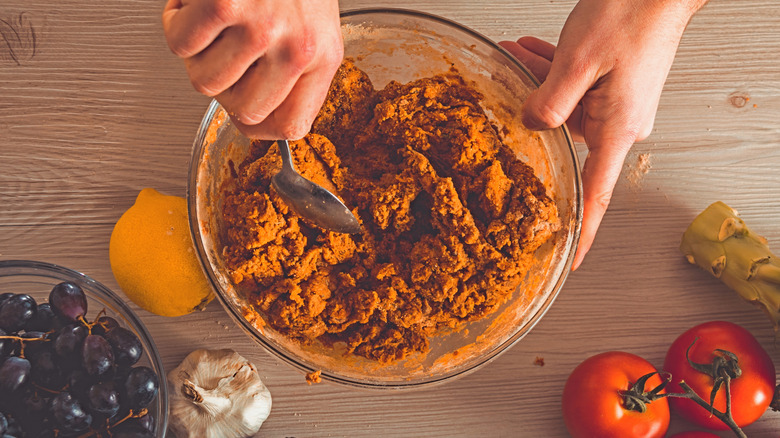Seitan Is The Underrated Ingredient For Vegetarians Who Miss The Bite Of Meat
For years meat alternatives have been growing in popularity. Between Impossible Meat, Beyond Meat, tofu, tempeh, and veggie blends, it is easier than ever to find vegetarian options both for at-home cooking and at restaurants. But there's one meat alternative that has been around for generations — one that has actually been lauded as having a texture far closer to meat than other options — that's often left out of the conversation: seitan.
Seitan (pronounced "say-tan") has been around for a long time, about 1,520-some-odd years. The meat alternative, which was originally made by vegetarian Buddhist monks in China, is made from wheat gluten and water (in its simplest form). Of course, you can add flavors depending on your desired taste, but the main draw to seitan is the texture, which comes from its unique preparation. Generally, the gluten is mixed with wet ingredients to form a springy dough, which is kneaded and then divided into the desired shapes (chunks, tenders, steaks, etc.) and dropped into a simmering broth. The pieces are simmered to take on the flavor of the broth and fully develop the meaty texture.
Once the seitan is made, it can be cooked using various methods similar to the meat it so resembles, and its chewy, substantial texture means that it has a satisfying bite that other meat substitutes often lack. Whether it takes center-of-the-plate status in the form of a steak or it's used in fajitas or with a variety of sauces, it shines anywhere you would use meat.
Why is seitan such a good meat alternative?
Other meat alternatives, such as tofu and tempeh, are praised for their ability to take on any flavor. Both tofu and tempeh also contain high levels of protein and other nutrients (like iron and magnesium) while also bringing lower levels of saturated fats and cholesterol to the table. So why would anyone choose seitan over these other options?
Seitan is still pretty nutritious (low in calories, fat, and carbs, and high in protein), but the real difference between these foods is the texture. Tofu, made from soybeans, comes in many textures, ranging from silken to super-firm. The first is similar to feta or soft cheese, while super-firm is the only type that some describe as "meat-like." Tempeh, also made from soybeans, has a dense, almost tough, texture. But seitan has a texture that is described as very close to meat; the doughy, gluten-y pieces have a string-like look and feel to them, and a substaniality that makes them satisfying to chew. Depending on how you shape the seitan prior to simmering it, you can approximate different varieties of meat.
Seitan makes a good alternative in things like chicken tenders or juicy vegetarian steaks, and can also be used in a stir-fry, a masala dish, or even a copycat Olive Garden alfredo. If you are brand new in your vegetarian journey, or if you've been in it a while and really miss the bite of meat, seitan is your best bet.

